Monster Muleys: South Dakota Does It Again!
Tim Herald 11.29.17

Eight months ago, I wrote about a 2016 deer hunt in South Dakota where I was lucky enough to be on successful stalks for a mid-150s whitetail with my friend Casey Mendenhall, and a huge 198 mule deer buck for myself (photo below).
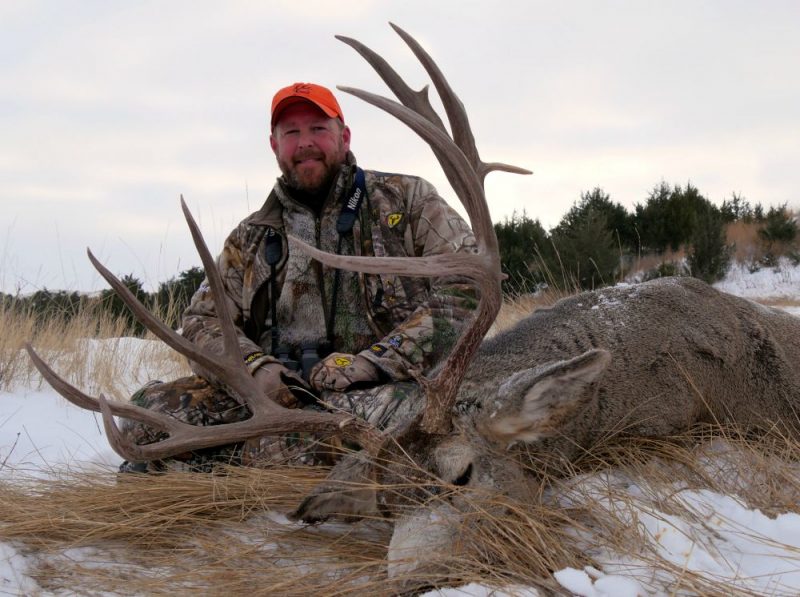
In spring of 2018, I drew another SD West River Special Buck tag through WTA TAGS application service, and with a few friends, we booked a hunt for November through WTA with my good buddy Tom McReynolds of Black Mountain Outfitters. Casey was joining me back in camp, as well as my frequent traveling companion Tom Niederer, and his buddy Jason Jensen, who was looking for his first mule deer.
On my previous trip, we had high winds, the temperatures had been brutally cold, with wind chills of minus 22 degrees, and snow covered the prairie. This year conditions were much milder, with lows between 18-25 degrees and highs from 45-55 degrees, and winds were calm at 5-10 mph. I wasn’t sure how the deer movement would be affected, but I knew going in that it would be a much more comfortable hunt.
I was hunting with Tom McReynolds, and he told me that he only had time to get out and scout the afternoon before. He spotted a medium-framed 3×4 with a harem of does, but he hadn’t turned up anything really big. I’d hunted the ranch we would be on before, and I knew that it held a good number of muleys and whitetails, so absolutely anything could happen.
The Search Begins
Just at daylight on opening day, as we entered the property, we spotted a big-framed whitetail buck. After checking him out with my Nikon EDG binos, I told Tom I thought he would easily break 160 inches. He was wide, tall and heavy, and he was 100 percent preoccupied with a hot doe. Tom asked if I wanted to try for him, and though I felt crazy saying “no,” I declined, hoping to find a big mule deer. If this happened during the second half of the hunt, I’m sure my answer would’ve been different. We watched the buck and doe run all over the prairie, and eventually disappear in a big canyon, and then we continued looking for mule deer.
It seemed that whitetails were absolutely everywhere. We glassed a long river-bottom, and we saw some decent-sized bucks and a number of does. We went to a different part of the ranch a couple miles away, and in every draw, there were whitetails bucks chasing or standing over does. Without exaggeration, I saw a dozen whitetail bucks that would score between 145-165 that morning, and six were over 150 inches. It was incredible.
We saw several mule deer bucks as well, but the best was a 4.5-year-old, with a rack that might have gone 170. He will be a great deer in 2 years.
I wasn’t expecting to find another deer that was pushing the 200-inch mark like my 2016 buck, but I had set my goal at finding a deer over 180. I told myself that the first buck like that I saw, I would try to take, and that didn’t matter if it was the first day.
(Note: I do want to say that I’m not at all hung up on antler score, and I’ve never entered a single animal in any record book. I simply use these numbers to give reference to a size class so you can quickly picture the kind of bucks I am talking about.)

That afternoon, Tom decided to go to the back of the ranch where he had seen the 3×4 the evening before. We saw a few deer here and there, but we didn’t find the big group of does he had seen before until about an hour before dark. They were a mile away, and they did have a nice-framed buck with them. Tom said he was sure it was the 3×4, but since we were running out of daylight, we decided to try to get a closer look.
Tom grabbed his spotting scope and went up on a ridge to get a better look while I organized my gear for the possible stalk. When I looked up and saw him coming back in a big hurry, I knew something was up. He explained that indeed it was the 3×4 with the does, but he glassed over in a big canyon to the west, and there was a really big muley headed toward the others. The problem was the big buck was 500 yards across the property line, and 800 yards from the deer on our side.
We didn’t know if he was actually coming to the other deer, and more importantly, we didn’t know if he had time to get on our property before dark. Again, we didn’t have time to do anything else, so we set off at a quick pace to cover the mile of rolling ground between us and the deer.
When we got to the last roll of the land before we expected to possibly see the deer, I took a short break to catch my breath. Tom moved a few yards ahead, and ducked down telling me that he’d seen one of the does go down into the draw just in front of us, and he figured all the deer were there. I ranged the far side of the draw with my Nikon 7i VR rangefinder, and it was only 244 yards. I knew we were close.
Tom and I slowly moved forward, trying to see into the draw before the deer spotted us, and then he grabbed my arm and pointed in front and to our left. The entire group of deer had moved toward the head of the draw, and they were all locked in on us from less than 150 yards. There were nine does, and a good-looking buck, but I quickly confirmed that it was the 3×4. He was wide and heavy, but not a deer for the first day.
Then Tom whispered, “The big buck is to the right!” I scanned that direction, and I saw a 2-year-old buck trotting toward the others. I told Tom he was tiny, and he said to look further to the right. When I did, I saw a big buck staring right at us, and I expected him to bolt any second. Tom commanded, “Shoot that buck!”
The does and the 3×4 trotted over the skyline, and I saw I wouldn’t be able to shoot at the larger muley because of the roll of the land. I had no choice but to go forward right at him. I hustled up another 25 yards, dropped on my knees and placed my rifle on shooting sticks. The big buck turned and trotted to where the other deer had been standing, but then he turned broadside, looking back at me. I put a CEB ER Raptor bullet right in the middle of his shoulder.
He spun around and was anchored, but I believe in shooting if an animal is moving at all, so I put another one in him just as he was falling. He didn’t go 5 yards.
I must admit — I had no idea how big the deer was, or wasn’t. I saw he was outside his ears, but when Tom said emphatically to shoot, I trusted him 100 percent, and just looked for the shot. I’m glad I didn’t hesitate and let the buck disappear over the ridge because as we walked up on him, his rack got bigger with every step.
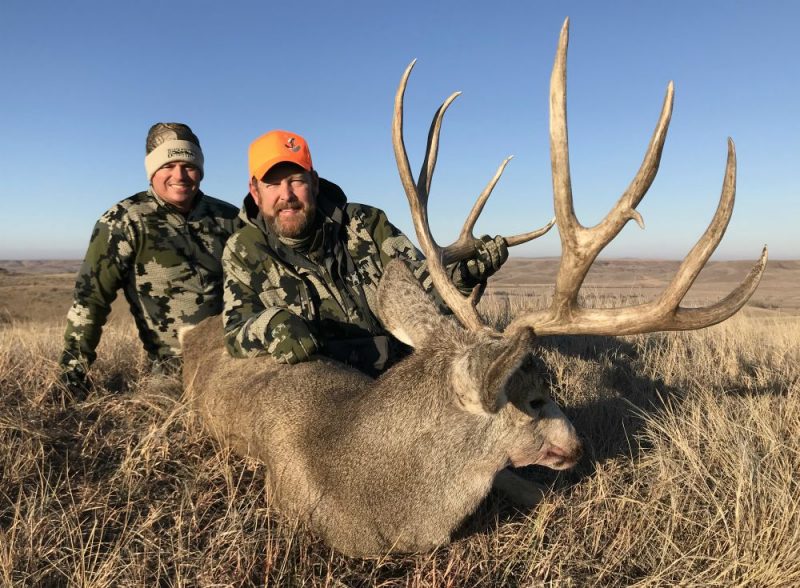
I think he was bigger than Tom thought as well, and when I picked up his huge antlers, I just couldn’t believe what had just happened so quickly. He was simply a beautiful 4×4 with brow tines and a kicker. He is the widest mule deer I’ve ever taken at 28.5 inches, and his rack really isn’t weak anywhere. I honestly never dreamed that I’d kill another muley in South Dakota that would break the 190 mark, but that is just what happened.
The next day, we took photos in the morning and scouted around for the other hunters. We got a call that Jason had taken a heavy, old mule deer, and it was certainly great to book him on the trip for his first muley.
My friend Casey and his buddy Pat joined us on the third day. Pat made a great shot on a beautiful buck in the first hour, and we looked over a lot of deer for Casey during the remainder of the day.
Casey At the Bat
The fourth morning we glassed a few deer, and then as we were driving up a long draw, I spotted a deer about 500 yards away in a gulley. Tom backed up and we saw that there were two bucks and several does, so we drove away and made a plan to stalk back.
We used the terrain to get 385 yards from the deer, and we realized there was a super-tall and fairly wide buck in the bunch. Casey got on the shooting sticks, but he couldn’t get a clear shot because the big buck was herding does. They eventually went over the ridge, so we hustled after them.
When we came over the ridge, they were all in a draw, and Casey sat down and quickly dropped the big buck from about 300 yards. The muley didn’t move a muscle. As we walked up on him, he began to move his head a bit, so Casey readied for another shot, but he couldn’t get an angle the way the buck was lying.
After 10 minutes of barely being able to move, the buck jumped to his feet and took off across the open prairie! Casey shot at him a couple times in mid-stride, but the buck went out of sight. We followed him, then Casey put him down for good, but to all of our surprise, the buck had only one antler. Evidently, on one of the running shots, Casey had creased the buck’s back and due to some weird angle, the bullet clipped his antler just above the base. We were all certainly glad to have the buck down, but I hated the situation for Casey.

As we recovered the deer, I got a text from Tom Niederer. He was being guided by my longtime friend Hunter Dane, and they had managed to stalk and kill a super buck. When I got to see it that evening, I was blown away. The muley was incredibly heavy for a prairie deer, and had huge beams, great forks and a couple kickers. We never taped the rack, but no doubt Tom’s deer was also over 190 inches.
I was incredibly happy for Tom. He’d hunted hard, passed some good bucks, had a monster give him the slip the day before, but he and Hunter persevered and came out with a phenomenal mule deer buck.
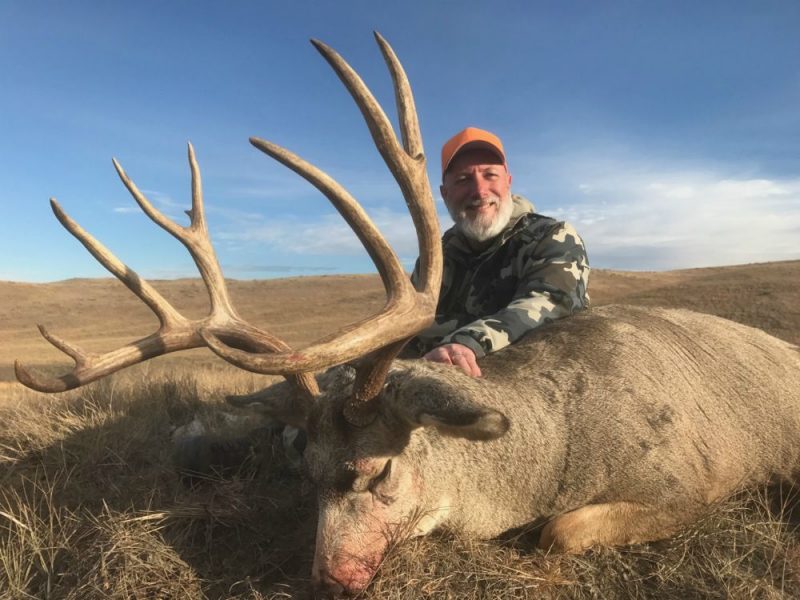
There isn’t much to say except South Dakota did it again for me, and my friends. We were 100 percent successful, and came away with some very impressive, mature deer. I absolutely cannot wait to go back.
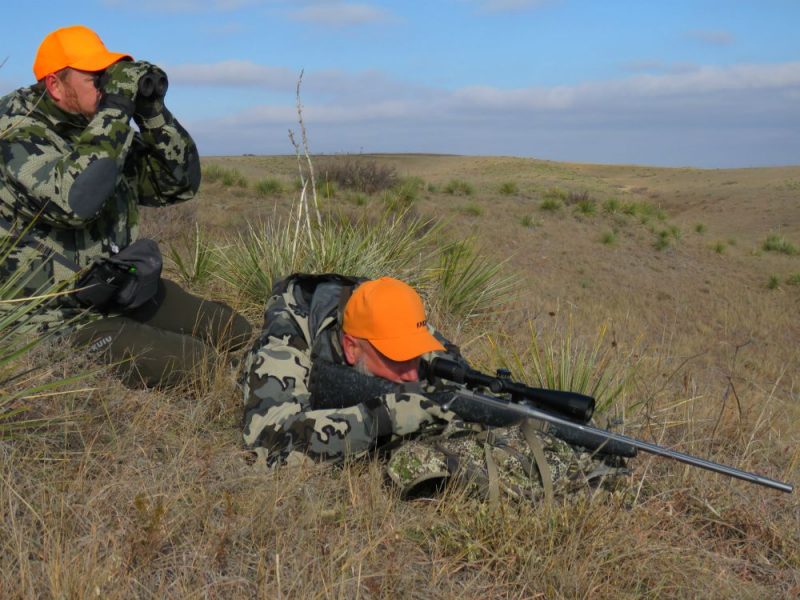
Sidebar: Gun, Optics and Load Combo for Success
On this hunt, I chose my favorite all-around caliber, the 300 Win. Mag., because I like a substantial round for big-bodied mule deer bucks. I carried my Sako A7 that I bought last fall but had yet to hunt with, and it is topped with a Nikon Monarch 5 4-20x50ED scope with a Custom XR Turret. With that turret, I can dial in the yardage in just a second to any range from 200-850 yards, and simply use my single crosshair. It makes long-range shooting very easy, but I didn’t really have to stretch things out on this trip.
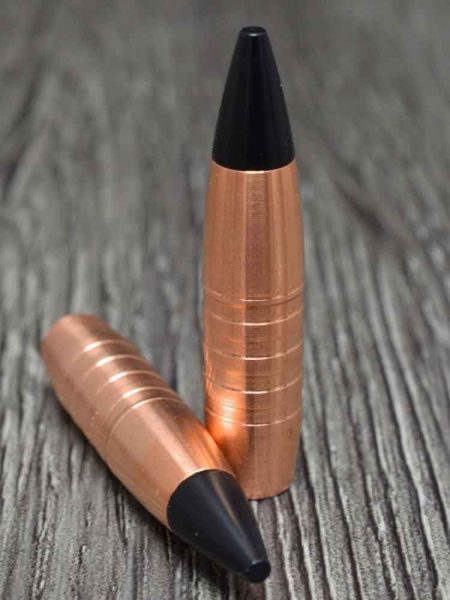
I love the Cutting Edge Bullets ER Raptor. It was devastating and performed perfectly. This is a tipped hollow-point design, and is intended for long-range hunting out to 600 yards. Instead of mushrooming, the Raptor bullets are all designed to shed six blades after 1-2 inches of penetration, while the base continues for even deeper penetration. I did get a complete pass-through.
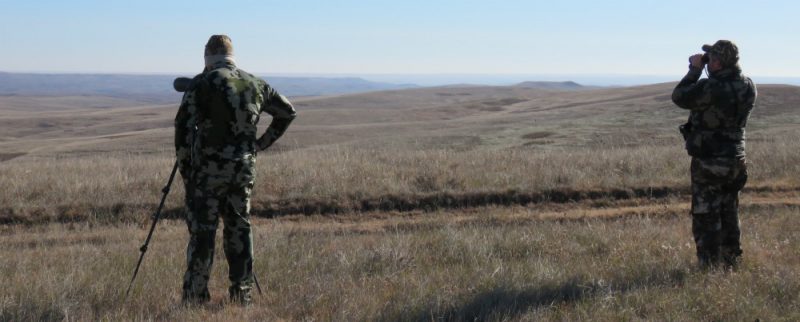
Sidebar: KUIU’s Midweight Outer Layers
There was a lot of variance in temperatures during this hunt — 18-55 degrees — so layering was essential, but I generally used KUIU’s Guide DCS vest and jacket as my outer layer on top, and their Attack pants on the bottom.
The Guide DCS Jacket is designed for varied conditions; it’s wind- and water-resistant, with enough breathability to wear while on the go. Multiple pockets, great durability, and a quiet insulated fabric make this KUIU’s most versatile jacket. This one is my go-to jacket on most hunts as an outer layer.
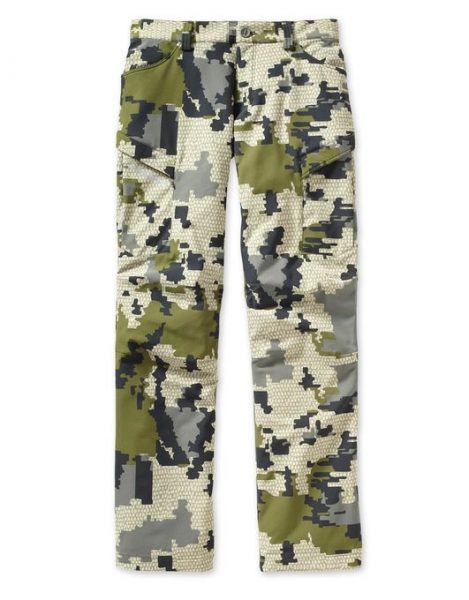
The Attack pants (above) are my favorite all-around hunting bottom I have ever worn. I wore a lightweight base layer under them and was comfortable the whole trip. The Attack has a single layer of four-way stretch Primeflex polyester, articulated knees, and a DWR finish for all-seasons performance (see video below). The pants are comfortable and quiet, and are good in a huge variety of applications from the rugged mountains of Asia, to the prairies of South Dakota, to a treestand in my home state of Kentucky.
Editor’s note: Tim Herald is an owner and hunt consultant at Worldwide Trophy Adventures (WTA). To book this or any other high-quality hunt anywhere in the world, contact Tim at tim@trophyadventures.com. WTA’s services are free; WTA is paid directly by the outfitter, and your hunt cost is the same whether you book directly with an outfitter or through WTA.

